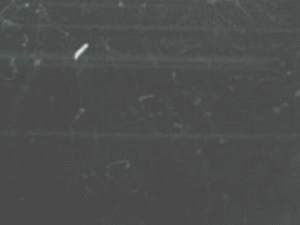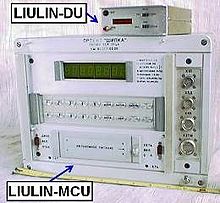
A diode is a two-terminal electronic component that conducts current primarily in one direction. It has low resistance in one direction and high resistance in the other.

A Geiger counter is an electronic instrument used for detecting and measuring ionizing radiation. It is widely used in applications such as radiation dosimetry, radiological protection, experimental physics and the nuclear industry.

Cosmic rays or astroparticles are high-energy particles or clusters of particles that move through space at nearly the speed of light. They originate from the Sun, from outside of the Solar System in our own galaxy, and from distant galaxies. Upon impact with Earth's atmosphere, cosmic rays produce showers of secondary particles, some of which reach the surface, although the bulk are deflected off into space by the magnetosphere or the heliosphere.
Ionizing radiation, including nuclear radiation, consists of subatomic particles or electromagnetic waves that have sufficient energy to ionize atoms or molecules by detaching electrons from them. Some particles can travel up to 99% of the speed of light, and the electromagnetic waves are on the high-energy portion of the electromagnetic spectrum.
Radiation protection, also known as radiological protection, is defined by the International Atomic Energy Agency (IAEA) as "The protection of people from harmful effects of exposure to ionizing radiation, and the means for achieving this". Exposure can be from a source of radiation external to the human body or due to internal irradiation caused by the ingestion of radioactive contamination.
In experimental and applied particle physics, nuclear physics, and nuclear engineering, a particle detector, also known as a radiation detector, is a device used to detect, track, and/or identify ionizing particles, such as those produced by nuclear decay, cosmic radiation, or reactions in a particle accelerator. Detectors can measure the particle energy and other attributes such as momentum, spin, charge, particle type, in addition to merely registering the presence of the particle.

Health physics, also referred to as the science of radiation protection, is the profession devoted to protecting people and their environment from potential radiation hazards, while making it possible to enjoy the beneficial uses of radiation. Health physicists normally require a four-year bachelor’s degree and qualifying experience that demonstrates a professional knowledge of the theory and application of radiation protection principles and closely related sciences. Health physicists principally work at facilities where radionuclides or other sources of ionizing radiation are used or produced; these include research, industry, education, medical facilities, nuclear power, military, environmental protection, enforcement of government regulations, and decontamination and decommissioning—the combination of education and experience for health physicists depends on the specific field in which the health physicist is engaged.
A semiconductor detector in ionizing radiation detection physics is a device that uses a semiconductor to measure the effect of incident charged particles or photons.
The ionization chamber is the simplest type of gaseous ionisation detector, and is widely used for the detection and measurement of many types of ionizing radiation, including X-rays, gamma rays, alpha particles and beta particles. Conventionally, the term "ionization chamber" refers exclusively to those detectors which collect all the charges created by direct ionization within the gas through the application of an electric field. It uses the discrete charges created by each interaction between the incident radiation and the gas to produce an output in the form of a small direct current. This means individual ionising events cannot be measured, so the energy of different types of radiation cannot be differentiated, but it gives a very good measurement of overall ionising effect.

Neutron detection is the effective detection of neutrons entering a well-positioned detector. There are two key aspects to effective neutron detection: hardware and software. Detection hardware refers to the kind of neutron detector used and to the electronics used in the detection setup. Further, the hardware setup also defines key experimental parameters, such as source-detector distance, solid angle and detector shielding. Detection software consists of analysis tools that perform tasks such as graphical analysis to measure the number and energies of neutrons striking the detector.

The Lazarus effect refers to semiconductor detectors; when these are used in harsh radiation environments, defects begin to appear in the semiconductor crystal lattice as atoms become displaced because of the interaction with the high-energy traversing particles. These defects, in the form of both lattice vacancies and atoms at interstitial sites, have the effect of temporarily trapping the electrons and holes which are created when ionizing particles pass through the detector. Since it is these electrons and holes drifting in an electric field which produce a signal that announces the passage of a particle, when large amounts of defects are produced, the detector signal can be strongly reduced leading to an unusable (dead) detector.

In dosimetry, linear energy transfer (LET) is the amount of energy that an ionizing particle transfers to the material traversed per unit distance. It describes the action of radiation into matter.
A Bonner sphere is a device used to determine the energy spectrum of a neutron beam. The method was first described in 1960 by Rice University's Bramblett, Ewing and Tom W. Bonner and employs thermal neutron detectors embedded in moderating spheres of different sizes. Comparison of the neutrons detected by each sphere allows accurate determination of the neutron energy. This detector system utilizes a few channel unfolding techniques to determine the coarse, few group neutron spectrum. The original detector system was capable of measuring neutrons between thermal energies up to ~20 MeV. These detectors have been modified to provide additional resolution above 20 MeV to energies up to 1 GeV.
FLUKA is a fully integrated Monte Carlo simulation package for the interaction and transport of particles and nuclei in matter. FLUKA has many applications in particle physics, high energy experimental physics and engineering, shielding, detector and telescope design, cosmic ray studies, dosimetry, medical physics, radiobiology. A recent line of development concerns hadron therapy.
RADOM is a Bulgarian Liulin-type instruments-type spectrometry-dosimetry instrument, designed to precisely measure cosmic radiation around the Moon. It is installed on the Indian satellite Chandrayaan-1. Another three instruments were deployed on the International Space Station. All Liulin-type instruments are designed and build by the Solar-Terrestrial Influences Laboratory at the Bulgarian Academy of Sciences.

Medipix is a family of photon counting and particle tracking pixel detectors developed by an international collaboration, hosted by CERN.
A microbeam is a narrow beam of radiation, of micrometer or sub-micrometer dimensions. Together with integrated imaging techniques, microbeams allow precisely defined quantities of damage to be introduced at precisely defined locations. Thus, the microbeam is a tool for investigators to study intra- and inter-cellular mechanisms of damage signal transduction.

Science and technology in Bulgaria is carried out in a variety of institutions, largely dominated by the Bulgarian Academy of Sciences (BAS) and several universities.
Cosmic Ray Energetics and Mass (CREAM) is an experiment to determine the composition of cosmic rays up to the 1015 eV (also known as the "knee prospect") in the cosmic ray spectrum.
Hybrid pixel detectors are a type of ionizing radiation detector consisting of an array of diodes based on semiconductor technology and their associated electronics. The term “hybrid” stems from the fact that the two main elements from which these devices are built, the semiconductor sensor and the readout chip, are manufactured independently and later electrically coupled by means of a bump-bonding process. Ionizing particles are detected as they produce electron-hole pairs through their interaction with the sensor element, usually made of doped silicon or cadmium telluride. The readout ASIC is segmented into pixels containing the necessary electronics to amplify and measure the electrical signals induced by the incoming particles in the sensor layer.











